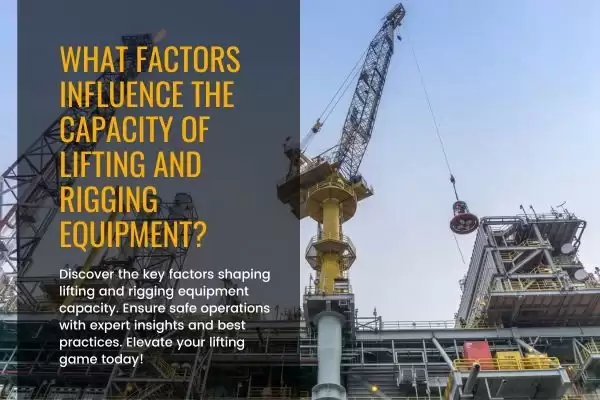100 %

Sep 26,2023
Lifting and rigging equipment are fundamental tools in various industries, enabling the movement and manipulation of heavy loads. Understanding the capacity of these equipment is paramount to ensuring safety and efficiency in operations. In this article, we will delve into the key factors that influence the capacity of lifting and rigging equipment, providing readers with essential insights for safe and effective use.
Lifting equipment encompasses a wide range of tools designed to hoist heavy loads. This category includes cranes, hoists, jacks, and winches, each serving specific purposes in lifting operations. The capacity of lifting equipment is determined by its design, material strength, and engineering specifications.
Rigging equipment comprises the components that secure and support loads during lifting operations. This includes slings, shackles, hooks, and cables. The capacity of rigging equipment is influenced by factors such as material strength, load distribution, and environmental conditions.
Lifting and rigging equipment find applications across various industries, including construction, manufacturing, maritime, and transportation. Understanding the specific demands of each industry is crucial in selecting and utilizing the right equipment for the job.
The material composition of the load and the equipment itself plays a pivotal role in determining lifting capacity. For instance, steel cables are used for their high tensile strength, while aluminum alloys offer a lightweight alternative. Additionally, understanding the weight distribution of a load is essential in preventing overloading and ensuring safe lifting operations.
The design and engineering of lifting and rigging equipment directly impact its capacity. Load-bearing components must be engineered to withstand the intended load, with safety factors to account for unforeseen stresses. Compliance with industry standards and regular inspections are crucial in maintaining the equipment's capacity over time.
Environmental factors can significantly affect the capacity of lifting and rigging equipment. Extreme temperatures, corrosive environments, and exposure to elements like saltwater can weaken materials and compromise their load-bearing capabilities. Regular inspections and maintenance routines should include assessments of environmental impact.
The operator's competence is a critical factor in ensuring safe lifting operations. Proper training and certification are essential in understanding equipment capacities, load dynamics, and safety protocols. Due to inadequate training, human error can often lead to accidents and equipment failure.
Static loads remain constant in magnitude and direction, while dynamic loads involve movement or changes in force. Understanding the nature of the load is crucial in selecting the appropriate equipment and ensuring safe lifting practices. Dynamic loads often require additional considerations to prevent accidents.
The center of gravity refers to the point at which an object's weight is evenly distributed. It is a crucial factor in load stability during lifting operations. Understanding the center of gravity allows for proper load attachment and adjustments, minimizing the risk of load shifting or tipping during lifting.
Routine inspections are imperative to identify wear and tear, corrosion, or other issues that may compromise the equipment's capacity. Visual checks, supplemented by non-destructive testing (NDT) methods, help ensure that equipment remains in optimal working condition.
Proper maintenance includes routine tasks such as lubrication, cleaning, and adjustments. Additionally, it involves timely replacement of worn components and addressing any identified issues promptly. Adhering to manufacturer recommendations and industry best practices is essential for maintaining capacity.
The Occupational Safety and Health Administration (OSHA) provides comprehensive regulations and guidelines for lifting and rigging operations. Familiarity with OSHA standards is crucial in ensuring compliance and maintaining a safe working environment.
The International Standards Organization (ISO) and the American National Standards Institute (ANSI) establish global and national standards for lifting and rigging equipment. Adhering to these standards helps guarantee that equipment meets established safety and performance criteria.
Understanding the factors that influence the capacity of lifting and rigging equipment is paramount in ensuring safe and efficient operations. Material strength, design considerations, environmental factors, and operator competence are crucial. Additionally, regular inspection, proper maintenance, and compliance with industry standards are essential practices in maintaining equipment capacity. By prioritizing these factors, industries can carry out lifting operations with confidence and safety at the forefront.